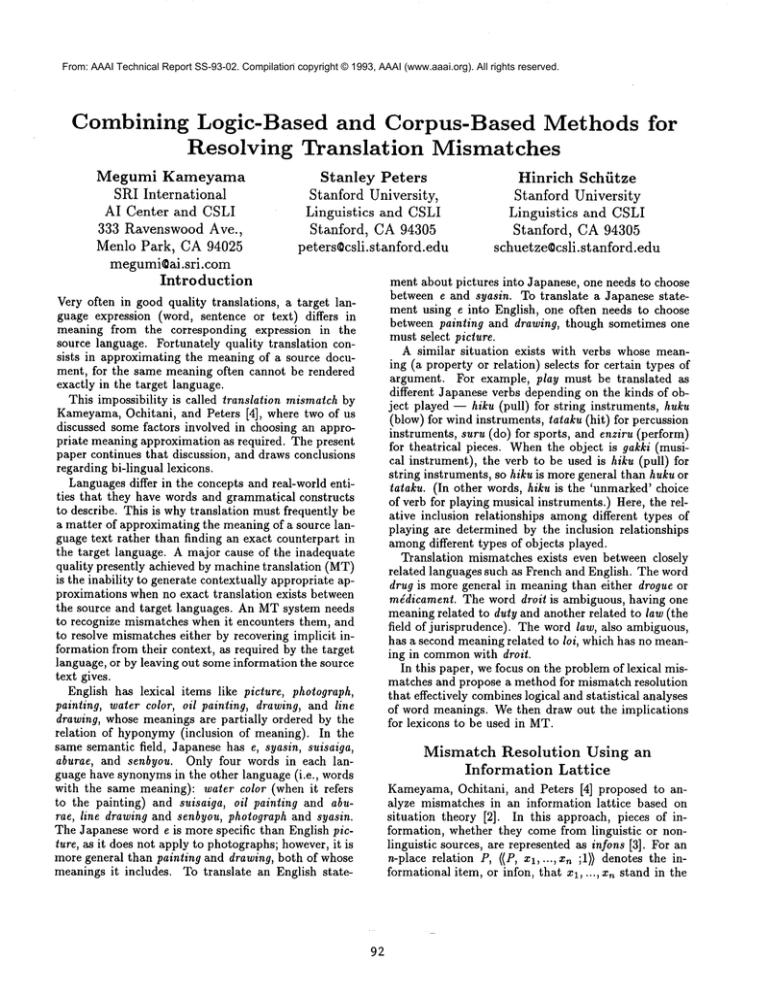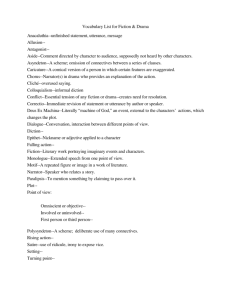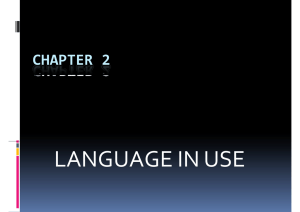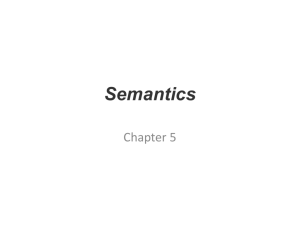
From: AAAI Technical Report SS-93-02. Compilation copyright © 1993, AAAI (www.aaai.org). All rights reserved.
Combining Logic-Based
and Corpus-Based Methods for
Resolving Translation
Mismatches
Megumi
Kameyama
SRI International
AI Center and CSLI
333 Ravenswood Ave.,
Menlo Park, CA 94025
megumi©ai.sri.com
Introduction
Stanley
Peters
Stanford University,
Linguistics
and CSLI
Stanford,
CA 94305
peters©csli.stanford.edu
Hinrich
Schfitze
Stanford University
Linguistics
and CSLI
Stanford,
CA 94305
schuetzeCcsli.st
anford.edu
ment about pictures into Japanese, one needs to choose
between e and syasin. To translate a Japanese statement using e into English, one often needs to choose
between painting and drawing, though sometimes one
must select picture.
A similar situation exists with verbs whose meaning (a property or relation) selects for certain types
argument. For example, play must be translated as
different Japanese verbs depending on the kinds of object played -- hiku (pull) for string instruments, huku
(blow) for wind instruments, tataku (hit) for percussion
instruments, suru (do) for sports, and enziru (perform)
for theatrical pieces. Whenthe object is gakki (musical instrument), the verb to be used is hiku (pull) for
string instruments, so hiku is more general than huku or
tataku. (In other words, hiku is the ’unmarked’ choice
of verb for playing musical instruments.) Here, the relative inclusion relationships amongdifferent types of
playing are determined by the inclusion relationships
amongdifferent types of objects played.
Translation mismatches exists even between closely
related languages such as French and English. The word
drug is more general in meaning than either drogue or
mddicament. The word droit is ambiguous, having one
meaningrelated to duty and another related to law (the
field of jurisprudence). The word law, also ambiguous,
has a second meaning related to loi, which has no meaning in commonwith droit.
In this paper, we focus on the problem of lexical mismatches and propose a method for mismatch resolution
that effectively combineslogical and statistical analyses
of word meanings. Wethen draw out the implications
for lexicons to be used in MT.
Very often in good quality translations, a target language expression (word, sentence or text) differs
meaning from the corresponding expression in the
source language. Fortunately quality translation consists in approximating the meaning of a source document, for the same meaning often cannot be rendered
exactly in the target language.
This impossibility is called translation mismatch by
Kameyama,Ochitani, and Peters [4], where two of us
discussed some factors involved in choosing an appropriate meaning approximation as required. The present
paper continues that discussion, and draws conclusions
regarding bi-lingual lexicons.
Languagesdiffer in the concepts and real-world entities that they have words and grammatical constructs
to describe. This is why translation must frequently be
a matter of approximating the meaning of a source language text rather than finding an exact counterpart in
the target language. A major cause of the inadequate
quality presently achieved by machine translation (MT)
is the inability to generate contextually appropriate approximations when no exact translation exists between
the source and target languages. An MTsystem needs
to recognize mismatches when it encounters them, and
to resolve mismatches either by recovering implicit information from their context, as required by the target
language, or by leaving out some information the source
text gives.
English has lexical items like picture, photograph,
painting, water color, oil painting, drawing, and line
drawing, whose meanings are partially ordered by the
relation of hyponymy(inclusion of meaning). In the
same semantic field, Japanese has e, syasin, snisaiga,
aburae, and senbyou. Only four words in each language have synonymsin the other language (i.e., words
with the same meaning): water color (when it refers
to the painting) and suisaiga, oil painting and aburae, line drawing and senbyou, photograph and syasin.
The Japanese word e is more specific than English picture, as it does not apply to photographs; however, it is
more general than painting and drawing, both of whose
meanings it includes. To translate an English state-
Mismatch
Resolution
Using
an
Information
Lattice
Kameyama,Ochitani, and Peters [4] proposed to analyze mismatches in an information lattice based on
situation theory [2]. In this approach, pieces of information, whether they come from linguistic or nonlinguistic sources, are represented as infons [3]. For an
n-place relation P, ((P, zl,...,Xn ;1)) denotes the informational item, or infon, that zl, ..., z, stand in the
92
EN:"picture" == P1 ((picture,z;
EN:"painting"
JA:"e" == P6 ((e,x;
((painting,x;
((oil painting,x; 1))P4
EN:"oil painting"
JA:"aburae"
1))
e (P6)). Wehave described these two general schemes
for resolving mismatches using the notion of information flow [4].
This approach also applies to lexical mismatches
where a verb’s meaning depends on its argument types.
In the play example discussed above, the English verb
must be translated as different Japanese verbs depending on the kinds of object played. Recall that the relative inclusion relationships amongdifferent types of
playing are determined by the inclusion relationships
amongdifferent types of objects played. In general, for
any n-ary relation P, the inclusion relationship of the
arguments determine the inclusion relationship of infons of P -- ((P, xl, ..., Xn;1)) =¢, ((P, yl,..., y~ ;1)) xi
=~Yi for all 1 < i < n.
Kameyama,Ochitani and Peters’ 1991 proposal [4]
was to use such a multilingual information lattice both
to recognize mismatches and to resolve them. Wecan
generalize their claim as follows: Given a linguistic form
signifying a property P in the source sentence SL, the
corresponding linguistic form in the target sentence TL
should signify, in the descending order of preference,:
1. the same property P,
1))
1))P2 P3 ((drawing,z;1))==
EN:"drawing"
P7 ((line drawing,z;1))
P5 ((water-color,x;1))
JA: "senbyou"
EN:"water-color"
JA:"suisaiga"
Figure 1: The "Picture" Sublattice
relation P, and/(P, xl, ..., x~ ;0/) denotes the infon that
they do not stand in the relation. Given a situation s,
and an infon ~, s ~ a indicates that the infon ~ is made
factual by the situation s, read s supports a .
Infons are assumedto form a distributive lattice with
least element 0, greatest element 1, set/of infons, and
1"involves" relation =~ satisfying:
for infons cr and r, if s ~ cr and ~r ~ r then s ~ r
This distributive
lattice (/, =~/, together with
nonemptyset Sit of situations and a relation ~ on Sit
x 1constitute an infon algebra [1].
The information lattice represents logical aspects of
the lexical and grammatical meanings expressed by
source and target languages -- inclusion relationships
amongrelated concepts and predicate-argument structures. The lexical meanings in this approach form
an information sublattice, and a bilingual or multilingual lexicon to be used for translation will represent
all the word senses of the given languages with all the
knowninclusion relationships made explicit. 2 Figure 1
(from [4]) is a lexical sublattice of somepicture words
discussed above, as an example of lexical mismatches
between English (EN) and Japanese (JA). The
ture words in question SIGNIFY (written ==) respective
word senses (or properties) P 1,...,P7 whoseinclusion relations are captured with the INVOLVES
relation (=¢,).
High quality translations generally preserve exactly
the same concept when possible, e.g., translate water
color (P5) as suisaiga (P5). Whenthe target language
lacks a word or simple phrase for something in the
source text, translation must either GENERALIZE
the
concept mentioned (e.g., translate painting (P2) as
(P6)) or SPECIALIZE
it (e.g., translate picture (P1)
2. the closest property P~ such that P =~ P~ (generalization),
3. the closest property P" such that pH =:¢, p (specialization),
4. or some property Q (in the neighborhood of P) that
is neither involved by P nor involves P.
Whenthe linguistic form in question is a complex
structure such as a sentence, the associated information is also a complex set of infons. Twosentences can
convey the same complex information even if the pieces
of information come from different kinds of linguistic
sources. In other words, the same pieces of information
can have DIVERGENT
sources in the source and target
sentences, and translation can still be said to preserve
the same information. For instance, consider the translation from English 3the red block is on the white block
into Japanese akai tumiki wa siroi tumiki no ue ni nolle
iru. The spatial relation described with on loses the information of contact when it is described with ue (’on’
or ’above’), but this lost information is regained by ni
nolle iru (be riding on), which specializes the relation
is on. Thus the preferred strategy for resolving lexical
mismatches is to allocate, if possible, the same pieces
of information in different parts of the phonologicomorpho-syntactic structure of the sentence. In this process, some lexical mismatches are resolved with generalization, others are resolved with specialization, and
yet others are resolved with some other strategy.
It is, however, not possible always to find an exact
translation for a given sentence. In the above example of blocks, for instance, the singularity information
1Weassume that the relation =~ on infons is transitive, reflexive, and anti-symmetric after Barwise and
Etchemendy.
2Weset aside for nowthe question of howsuch a bilingual
conceptual lattice wouldbe constructed, except to say that
it would draw on a combination of monohngualthesauri,
bilingual dictionaries, and introspection of bilingual speakers. Monolingual thesauri outline monolinguM
conceptual
lattices. Bilingual dictionaries outline the complexlexical
mappingsbetween the two languages. Bilingual speakers’
introspection backs up the generalizations obtained from
the first two sources. Wewouldlike to makethis construction process semi-automatic,but howit can be done is still
unclear.
3Assumethat the context gives the information that the
red block is on top of the white block.
93
of each block is totally lost in the natural translation
in Japanese. Wemust, therefore, find a way to move
within the information lattice to find an optimal translation.
Generalization is preferred because it is often a safer
translation strategy than specialization -- that is, it
does not overcommit. For instance, translating
a
Japanese sentence watasi wa kono e ga suki desu (I
like this ’e’) into English I like this picture is safer
than, say, I like this painting unless the discourse context specifies the referent of ’e’ to be a kind of painting. A sound mismatch resolution strategy thus must
take into account the information obtained from the
discourse-specific context, so that the context allows
specialization of mismatches without false overcommitments. In other words, the information associated with
a sentence in discourse is not just its linguistic meaning
out of context but is its linguistic meaningfleshed out
in the given discourse context -- what we call the UTTERANCE
MEANING.
In the next section, we will spell
out (1) what is an utterance meaning and (2) what
closeness of information.
Approximating
the Utterance
Meaning
It is useful to distinguish between the linguistic meaning of an expression in a language and the utterance
meaning expressed by using that expression on a particular occasion. An expression possesses its linguistic
meaning independently of any context in which it may
be produced or interpreted. The utterance meaning of
any utterance is a function of the linguistic meaningof
the expression uttered together with specific features of
the context in which it is uttered. Wehave seen that
a good translation of a word or sentence often has a
different linguistic meaning than the original. Next we
will show howthe utterence meaning of source and target expressions in context are often much closer than
their linguistic meanings.
The information carried by a sentence varies with
context as a result of several causes.
1. The intended structure and meaning of an ambiguous sentence depends on the context in which the
sentence is used.
2. The literal interpretation a given meaningyields is a
function of indexical factors.
3. The focus, salience, and Gricean implicatures along
with other communicative impacts determined by a
given literal interpretation vary according to context.
4. The picture a sentence portrays in context adds to its
communicative impact certain information obtained
from logical implications, natural laws, and other
contingently true generalizations about the domain
of discourse.
The information given by a sentence in context is the
result of the action of all these factors. This is the
UTTERANCE MEANING of a sentence.
In Kameyama,Ochitani, and Peters (1991), we employed situated utterance representations (SURs)
four-tuples ( DeT, PS, DiS, US) -- to formalize sentences in context.
Described Situation
Type (DeT) The way a certain piece of reality is, according to the utterance
Phrasal Situation Type (PS) The surface form
the utterance
Discourse Situation Type
of the on- going discourse
duced
Utterance Situation Type
ation where the utterance
(DIS) The current state
whenthe utterance is pro(US) The specific
is produced
situ-
The components of a SURcorrespond to context and
different aspects of its effects as follows. DeTcorresponds to the output of item 2, PS to the structural
part of the output of item 1, DiS to the contextual inputs of item 3, and USto the contextual inputs of items
1 and 2. The information given by a sentence in context, item 4, is not directly represented in a SUR.
When comparing a source sentence’s
SUR ( DeT,
PS, DiS, US ) with the SUR( DeT~, PS~, DiS~, I)
US
of its translation, the literal interpretations, DeTand
DeT~, can be very different in the case of translation
mismatches. Because translators take context into account, translation approximates between the contextdependent information (utterance meaning) that is the
closure of DeT or DeTI under Gricean and other communicative effects as well as under logical and natural
laws and various contingent generalizations.
To show how similarity between such utterance meanings can be used to define the translation relation
between source and target SURs, we make use of the
notions defined in the next section.
Measuring Informational
Distances
Wepropose to measure informational distances in terms
of neighborhoods (open sets) in a topology of information:
DEFINITION.Item il of information is as near to
i2 as i3 is if every neighborhood(open set) containing both i2 and i3 contains il.
The appropriate characterization
of open sets makes
this definition equivalent to the condition that the information i2 A i3 includes il A i2.
The relevant notion of inclusion of information is
given by the combination of logical implication (::~z),
communicativeprinciples (=~c), natural laws (=¢’n),
other contingently true generalizations about the domain of discourse (:Od). These heterogeneous principles combine to determine the utterance meaning -the information given by a sentence in context from the
sentence’s literal interpretation. Wecan define overall
information inclusion =~ as the union of all these different sources of informational inclusion:
When a lexical item appears in an downward monotone position, for instance, in the scope of a negation, replacing it by a more specific item yields a sentence whoseinformation generalizes that of the original.
For example, consider the lexical mismatch around the
’clock’ words in English and Japanese. Japanese tokei
(time pieces) means either watches (worn time pieces)
or clocks (not worn). Thus in translating I have no
clocks into Japanese, it is not conservative to generalize ’clocks’ into ’tokei’, producing watasi wa tokei wo
motteinai (I have no time pieces), since this specializes
the information of the overall sentence and it is possible
that the speaker has a watch. Depending on what open
sets the context determines, one might instead specialize and translate clock into mczamasidokei (alarm
clock), yielding the generalization watasi wa mezamasidokei wo motteinai (I have no alarm clocks) of the overall sentence’s meaning.
Note that a good translation must be a minimaigeneralization in the given context. In the above ’clock’
example, for instance, the context should place ’alarm
clock’ close to ’clock’ since the source sentence does not
specifically
mention alarm clocks. Depending on the
particular context, some other translation maybe better. The next section discusses how context-dependent
closeness of information depends on a given discourse.
DEFINITION. ~ = (~t U ~ U ~ U ~d)*
Then the collection of open sets {ili ~ ~ i) for all items
i ~ of information forms a topology, the appropriate one
for approximating information in translation.
Direction
and Distance
of Mismatch
If the information of a source language sentence cannot be reproduced exactly with a sentence of the target
language, each site of a mismatch between the two languages must be resolved to produce an overall adequate
approximation. Mismatch resolutions can
1. lose context-independent
information,
more general (generalization),
becoming
2. add context-independent
information,
more specific (specialization),
becoming
3. do neither, becoming incomparable (neither
general nor more specific).
more
Generalization chooses target information that includes the source information. Specialization chooses
target information that is included in the source information. In our topology, ’generalizing’ corresponds to
choosing a target expression whose information lies in
an open set containing the source information.
In translation mismatches, generalization is the more
conservative strategy because it is guaranteed to preserve accuracy of information. However, the generalization should be slight, or else a good deal of information will be lost. Wewish to explore the hypothesis
that minimal generalization is always the best strategy in translation -- that is, translators always aim to
choose a target sentence that in context gives information which lies in a small open set around the information given by the source sentence in its context. We
state the following principle:
Change
of Topology
with
Context
One way to regard the reason why a word or sentence
can have different best translations in different contexts
is to consider as context-dependent the topology of literal information content, the topology varying especially with communicative effects (=~¢) and with some
domain facts (=~d).
While an expression can express different utterance
meanings in different contexts, and an utterance meaning can be expressed by different expressions in different contexts, the topology of utterance meanings themselves is relatively fixed and independent of context.
What we do here is rearrange in a context-dependent
way the topology on literal interpretations -- collapsing
distinct ones that give rise to the same utterance meaning in a given context -- so that the result is isomorphic
to the topology of utterance meanings themselves.
Interestingly, only some generators of the topology
vary with context; ::~l and ::~n are relatively constant.
If we distinguish between atemporal and temporal determinants of the topology corresponding to the relative
temporal stability, the most stable is logical implication
(::~t) and the second most stable is the natural laws
(::~n). Wemayconsider them fixed in each translation
instance. In contrast, communicative effects and perhaps some domain facts depend on things that change
across translation instances.
Noweach of these four types of information inclusion
generates a topology by itself, and the topology we desire for approximating information is their product. So
it is useful to factor it into componentsthat are sta-
PRINCIPLE.Minimal generalization is always the
best strategy in translation.
The viability of this hypothesis depends crucially on
recognizing it is context-dependent utterance meaning,
not context-independent linguistic meaning, that the
best translation generalizes. In the terms of the previous section, ( DeT, PS, DiS, US) ,,~ ( I, PS~, DiS~,
t of the tarUS~) holds iff the literal interpretation DeT
get utterance is in a sufficiently small open set around
DeT.
The validity of this principle depends on two important facts about the context-dependent information.
One is that the topology of information is contextdependent; the neighborhoods around an item of information shift in a regular way as =~ and =~d vary
with context. Wediscuss this fact further in the next
section.
The second crucial fact is that manyapparent cases
of mismatchresolution by specialization receive a regular explanation in terms of generalizing the contextdependent information given by the whole sentence.
95
tionary and others that vary with time. It is, however,
unclear exactly how to obtain these different kinds of
topology, especially those that vary with the discourse
progression that are supposed to contain information
such as the subject matter, the speaker’s purpose, attitudes and perspectives, and the currently salient entities.
This is where we propose to make use of the
statistical
information obtained from alined bilingual
corpora.
with French word wi occurring in the French sentence
and English word wj ocurring in the English sentence.
(The bilingual sublexical space computed for this paper is based on a slightly different and computationally
less expensive procedure.) The Canadian Hansard with
Ken Church’s alignment was used here.
Mismatch resolution
can then be performed by
searching the space for the word in the target language
that is closest to the original word in the source language. If there is a one-to-one correspondencefor a particular pair of words from source and target language,
then they will occupy the same location in the space.
In the case of a mismatch, the word in the source language doesn’t have a direct translation, and it does not
share its location with a word from the target language.
Choosing the closest word as a translation, minimizes
the mismatch between original and translation with respect to the semantic and pragmatic regularities that
were automatically extracted by the principal component analysis.
A different way to view this proceeds by noting that
the clusters of a given word’s vectors in context space
correspond to different TOPICFIELDSin which the word
is used -- to contribute particular utterance meanings
to a larger discourse. If the word’s utterance meaning
is unambiguously determined by its topic field at each
occurrence, then determining the topic field should be
valuable in figuring out which target word will have
approximately the same utterance meaning in the given
context. This observation will be important when we
take up dictionaries for MT.
Mismatch Resolution using Sublexical
Space
Another way to view the fact that good translations
approximate the source’s utterance meaning, and our
theory of this, is as follows. With respect to lexical
meaning, we can observe that each specialization of a
word’s linguistic meaning to an utterance meaning is
associated with a particular type of utterance context.
Suppose we could find a way to determine when the context of a given use gives rise to a particular utterance
meaning; then we could choose a translation appropriate to that utterance meaning.
Schiitze’s work on word sense disambiguation is directly pertinent to this problem. His algorithm uses
SUBLEXICAL
REPRESENTATIONS [6] derived from a large
text corpus. First, a collocation matrix is collected for
several thousand high-frequency words. Each element
ai,i in the matrix records how often words wl and wj
co-occur in the corpus (in a sentence or in a window
of, say, 100 words). A principal componentanalysis is
then performed on the collocation matrix and on the
order of one hundred principal components extracted.
As a result, each word is represented by a vector of
100 components. The vector representations
capture
semantic and pragmatic regularities to the extent that
collocations characterize the set of topics and contents
in connection with which a word can be used.
The key information captured in the space is SEMANTIC SIMILARITY.
The closest neighbors of a word in the
space (according to some measure such as the cosine)
are semantic cognates. The more distant two words are
from each other in the space, the more different are the
semantic fields they belong to. An approximate representation of the topical character of the context of a sentence can be computed by summingup the vectors of all
words in the sentence (or computing their CENTROID).
Disambiguation proceeds by clustering the vectors of
all contexts that an ambiguousword occurs in, assigning senses to the clusters (by inspecting a few samples
from the cluster) and disambiguating a new context of
the ambiguous word depending on which cluster it is
closest to. Disambiguation rates between 89% and 96%
were achieved using this algorithm [6].
This framework can be extended to representing
words from several languages in the same space with
the help of an aligned corpus, for instance by collecting
a matrix that records co-occurrence in the aligned corpus such that ai,j counts the number of sentence pairs
Lexical
disambiguation
resolution
and mismatch
An ambiguous word can be disambiguated to different
linguistic meanings as a function of context, just as a
single linguistic meaningof a word can give rise to different utterance meanings in different contexts. Both
phenomena(as well ’as their combination) cause contextual variation in what target expression is the best
translation of a given source expression.
It is worth noting that to translate we needn’t settle
whether, for instance, the English word drug is ambiguous between ’medication’ and ’substance that causes
addiction,’
or unambiguously means something that
generalizes both these putative senses. Choosing the
appropriate one of the two French words drogue (illegal drugs) and mddicament (prescription drugs) as
translation can proceed similarly in terms of the topic
fields obtained from corpora. The different utterance
meanings of drug correlate with different topic fields,
whether they arise from different linguistic meanings or
the same one. Although it is sometimesdifficult to sort
out ’mere’ differences of utterance meaning from genuine ambiguities of linguistic meaning, this need not
impede translation on our approach.
If drugs is ambiguous between DRUGS1(illegal
drugs) and DRUGS2
(prescription drugs), sense disam-
96
biguation by topic spaces solves the problem of transbe a comparable distance in semantic content to a diflating into French, as DRUGS1
translates into drogue
ference of just one arc in a sparsely populated part of
and DRUGS2
translates into mddicament in one-to-one
the lattice (cf. Resnik 1992 [5] who points out simifashion. If drugs has only one sense DRUGS,on the
lar problems with WordNet). Second, world knowledge
other hand, the topic spaces corresponding to its differand the specifics of the text sort to be translated may
ent utterance meanings helps choose the French transplay a crucial role in determining what translation is
lation. Either way, the two distinct topic fields for drugs
best. If a French novel speaks of a gouache in describare:
ing a room’s decor, the best translation might well be
a general term like watercolor if the technically correct
DRUGS1
word in the target language would be inappropriate for
(addictheroinpusherssni f fingthugsvialsnarcotic)
the general readership of a novel. In an art book, on
DRUGS2
(medicalPreventivephysicianspatientdiagnosesneurosuro~ther
hand, the technical term would be required.
VBfft the linguistic Knowmage
that the lattice is based
It is possible, however, to identify true mismatches
on does not offer any clues as to how the measure of
using a set of linguistic tests such as gapping and "how
semantic relatedness could be adapted to different text
many" questions. For instance, we have determined
sorts.
that the clock-words in English and Japanese present
In the space, the measure of relatedness is the cosine
a true mismatch. For a question tokei wa ikutu motte
of the angle between two vectors representing contexts
imasu ka (how many ’tokei’ do you have?), the answer
or words. The vectors are based on the collocational
has to count all the watches and clocks (but not the
patterns of words where context words a distance of 5
stop watches). This shows that the Japanese word tokei
awayfrom the word being classified are as important as
does not have different senses for ’clocks’ and ’watches’.
context words at a distance of 30. Furthermore, syntacThus in translating the word tokei into English, we must
tic structure is ignored. As a result, the vectors repreperform a mismatch resolution rather than sense disamsent well what the word is used to talk about; but they
4biguation in the context.
contain very little information about what is actually
Even though these statistical methodsof corpus analsaid. For example, the closest neighbor of French verl is
ysis do not identify the utterance meaningof an expresred, not green. Antonymsoften end up as close neighsion in context, they do provide a highly useful empiribors.
Oversimplifying only slightly, one can say that
cal constraint on the adequacy of detailed descriptions
the propositions p and ~p occupy the same location in
of the linguistic meaning of English and French words
the space.
together with an account of howthese give rise to utThe crucial observation is that the two representaterance meanings in context. The utterance meanings
tional schemes get at INDEPENDENT
aspects of topicpredicted by such descriptions for English and French
content.
Whereas
the
space
is
finely
tuned to the pragshould be closely similar in precisely those cases where
matic
factors
affecting
the
composition
of text, the latthis analysis of corpora shows that English and French
tice
represents
predicate-argument
structure
and logiwords or phrases are good translations of each other.
cal relationships that are necessary for a description of
what the proposition expressed is (vs. what the entities
and situations talked about are). So combining the two
measures of relatedness should give us the best of both
worlds: logical clarity as well as pragmatic sensitivity
to the particulars of the application text.
Combining these schemes seems natural for two reasons. Encodinga dictionary by hand is feasible with the
investment of a couple of person-years. Representing
all world knowledge necessary for a given task is much
more labor-intensive. Secondly, different world knowledge is needed for each new application whereas the
linguistic properties of texts are more stable across different genres. Using a trainable, albeit simplistic, component for world knowledge and an expensive, but theoretically well-founded component,for linguistic knowledge could thus prove to be the optimal combination.
Synthesis
We have presented logic-based and corpus-based approaches to detecting and resolving mismatches in machine translation. They are needed because frequently
no expression in the target language expresses all and
only the information presented in the source language.
Both the vector space and the information lattice define measures of relatedness helpful in selecting plausible candidates for the best compromise between the
demands of specificity and correctness. However, both
measures are problematic if used on their own.
In the lattice, the measure of relatedness is the number of rungs that have to be traversed to get from the
meaning and structure of a source language expression
to an expression in the target language. In the simplest case, adding or removing one infon corresponds
to traversing one rung. Twoimportant problems exist
with this measure. First, some parts of the hierarchy
may be analyzed more finely than others. A large number of arcs between two points in a dense part may
Implications
for MTlexicons
Linguists usually regard the semantic task of a lexicon
to be stating the linguistic meanings of the words of a
language, and the job of semantic rules to be stating
how the linguistic meaning of syntactically generated
4Wedo not knowyet what topic spaces tokei wouldshow.
97
phrases and sentences are composedfrom the linguistic
meanings of the lexical items they include. Lexicographers have taken varying stands on what meanings
should be entered in a dictionary. Roughly speaking,
the so-called splitters favor listing each possible utterance meaning of a word separately in the dictionary
(while indicating similarities amongrelated utterance
meanings, of course). So-called lumpers, on the other
hand, wouldlist in one entry a single linguistic meaning
that gives rise in context to multiple utterance meanings.
Bilingual dictionaries list source words with (in principle) all the various target language words they translate to. One problem in using these dictionaries is that
they often give inadequate information to determine
which translation is best in a given context.
Our techniques permit the construction of a bilingual
dictionary in which each word is entered by associating each topic field in which it is found with the word
(or words) of the other language that translate it
that context. The topic fields can be constructed automatically from a large corpus, and the topic-specific
translations can also be constructed automatically from
a corpus of translations.
Such an automatically constructed bilingual dictionary for MTcan be seen as a
natural generalization of traditional bilingual dictionaries, whichattempt to give crude topic fields (e.g., ’military’, ’law’, etc.) as a basis for choosingthe translation
of a word.
It may be that words cluster into more regions of
context space than they have utterance meanings. This
need not prevent the compilation of useful bilingual dictionaries, however. By employing a characterization of
contexts grounded in an appropriate corpus of a language, and a large enoughcorpus of translations to find
translation pairs in a wide range of topic fields, we may
reasonably hope to find the occurrences needed for compilation of a dictionary that generalizes adequately to
new documentsthat are sufficiently like the corpus.
While such a bilingual lexicon will not meet linguists’
goals of representing each word’s linguistic meaning in
a unified way, it will nevertheless provide crucial empirical data for testing the correctness of linguistic lexicons when they becomecapable of predicting utterance
meanings in terms of linguistic meanings and contextual factors. Whatever the contextual facts may be in
a given topic field, the linguistic lexicon should predict
an utterance meaningthat is close to the one it predicts
the best translation word has in the same context.
[2] Barwise, Jon, and John Perry. 1983. Situations and
Attitudes. Cambridge, MA:MIT Press.
[3] Devlin, Keith. 1991. Logic and Information. Cambridge, England: Cambridge University Press.
[4] Kameyama, Megumi, Ryo Ochitani, and Stanley
Peters. 1991. Resolving translation mismatches with
information flow. In Proceedings of the 29th Annual
Meeting of the Association of Computational Linguistics, Association of Computational Linguistics,
193-200.
[5] Resnik, Philip. Forthcoming. WordNetand Distributional Analysis: A Class-based Approach to Lexical Discovery. In Weir, Carl; Abney, Stephen; Grishman, Ralph; Weischedel, Ralph (Eds.). Forthcoming.
Statistically-Based
NLP Techniques. AAAIPress.
[6] Schfitze, IIinrich. 1992. Dimensionsof meaning. In
Proceedings of Supercomputing.
References
[1] Barwise, Jon and John Etchemendy. 1990. Information, Infons, and Inference. In Cooper, Robin, Kuniaki Mukai, and John Perry (eds) 1990. Situation
Theory and Its Applications, Volume 1, CSLI Lecture Notes Number22. Stanford: CSLI Publications,
33-78.
98






